Jan Bergstra & Laurens Buijs
Amsterdam Gender Theory Research Team
We have several goals with AGTRT, and one is to use formal gender theory(FGT) to establish a new approach within gender theory. We want to list here what we think is really new about our approach.
- We assign a major role to Alex Byrne’s claims AHF and AHM:
AHF: a woman is an adult human female,
AHM: a man is an adult human male.
Byrne advocates accepting the truth of AHF and AHM. But unlike Byrne, we see these two claims as false. Better:
AHF*: most women are adult human females,
AMF*: most men are adult human males, and
neg-AHF: some women are not adult human females,
neg-AHM: some men are not adult human males.
- Robin Dembroff elaborated on AHF and AHM. Dembroff sees nothing wrong with that, but does not conclude that AHM and AHF would be false in a literal sense. To reach that conclusion, it is obvious to give male/female a more bodily interpretation than man/woman, and Dembroff does not want to go that way.
Unlike Dembroff, we see AHF and AHM as perfectly adequate claims within gender theory, albeit that we do not find AHM and AHF to be true in an absolute sense (or by definition). AHM and AHF can be compared to “birds can fly” or “birds have wings” those statements are true “by default” but there are exceptions, even if not many.
- The combination of the positions under 1) and 2) is as far as we can see (and assessed in the summer of 2023) a new one within gender theory.
- We label what Helen Joyce calls “gender identity ideology” (see AGTRT-BF88) with the more neutral term co-essentialism (and it is then complementary to essentialism).
With essentialism and co-essentialism comes a certain symmetry in the (yet conflicting) positions prevalent within gender theory. The next new point is that we try to name the middle ground between these positions and achieve a MotR(middle of the road) approach to gender theory that is useful to many.
- We resolve the formidable ambiguity of the term gender by disambiguating it very explicitly. Thus, 5 specific notions of gender emerge: physical gender, psychological gender, social gender, formal gender, and legal gender.
- Formal gender we use as the default for gender (if no additional qualifier is added). The concept of formal gender arises through concept engineering (an idea that is certainly not new in gender theory, and which we are happy to adopt). We elaborate on these issues using the ICE method(incremental concept engineering, see AGTRT-BF56).
Learn more about the basics of gender and FGT’s role in it:
What is gender anyway, and why is biological sex not enough?
Formal Gender Theory (FGT) began in AGTRT-1 as a formal/logical approach to gender theory. but we now prefer to think of FGT as a concept-based approach to gender theory. We have thus moved from F(GT) to (FG)T (to think in formal terms, see also AGTRT-BF8).
We by no means claim that within gender theory there would be no room for an approach other than FGT. In any case, FGT is in competition with philosophically well-crafted essentialism (Alex Byrne, Tomas Bogardus, Hele Joyce) on the one hand and philosophically well-crafted co-essentialism (Robin Dembroff, Elizabeth Barnes, Cameron Kirk-Gianinni) on the other
We certainly do not support the striking arrogance with which gender theory is brushed aside in general terms from the Vatican (see AGTRT-BF76). Gender theory is precisely the field of study in which the conflict is taking place that worries the Vatican.
We compare this situation with the striking year 1616: astronomy was the field within which to maintain the Vatican’s opposition to the heliocentrism of Copernicus and Galilei. The Vatican did that in 1616 by forcing Galileo not to propagate heliocentrism, but not by abolishing astronomy.
It is incomprehensible that the Vatican is so concerned about gender without simply acknowledging the existence of gender theory through the front door and without recognizing that its own positions must also have a place within gender theory. Even the statement that gender would not be“socially constructed,” which is what the Vatican seems to think, is a statement from the social sciences and its philosophy.
